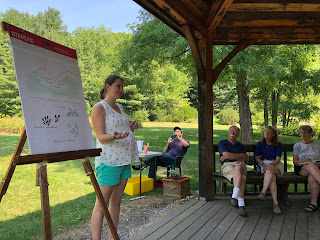The question is not what you look at but how you look & whether you see.
Thoreau in his Journal, 1851
Orange, grass-killing fungus, or something else?
Walking across a large playing field in Newton Center, I noticed grass splayed out in a circle about a foot across, and outlined by a bright orange ring. My first impression was that a fungus must be killing the grass plant, causing it to fall over from its central root, with orange fungal spores emerging mid-stem. Closer examination showed that many such orange circles occurred in a regular pattern across the field, and the orange seemed more like paint than fungus. In fact, I soon realized, the orange color was spray paint indicating below ground irrigation nozzles.
Close-up of the orange circle. Looks like paint!
Walking in the Hammond woods, I spied what seemed to be a blazing white gem in the shaded forest. The gem, about a foot across and three feet above the ground, shimmered with brilliant white light, changing by the moment. As I got closer, I could see that it was an unstructured three-dimensional spider’s web, backlit by a stray sunbeam, with the spider visible at the top of the web.
Shimmering white gem in a shady forest. See the spider?
Two amazing novelties during walks along well-worn paths.








